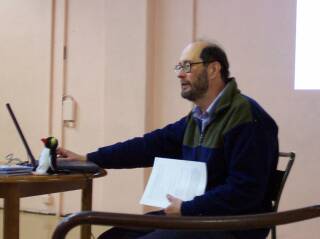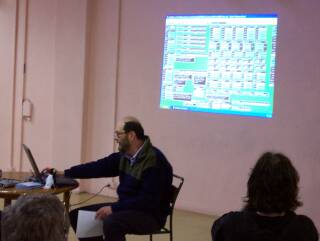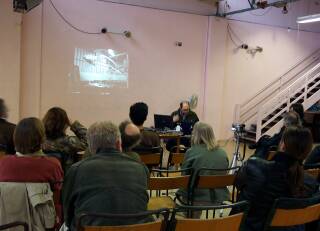


Warren Burt - The Wilson Installations
reviewed by John Jenkins
Warren Burt is a pivotal figure in the Australian new music scene. A composer, improviser and educator, as well as writer and broadcaster, he has collaborated widely with dancers and other artists, while acting as occasional roving ambassador, cementing ties with many US and other leading lights in the field.Although the range of Burt's work is extremely wide, the focus of his talk was just three recent works, The Wilson Installations, which form a closely related set.
There is a strong, philosophical rationale underpinning these works. Their aim is nothing less than to "…try and help us reclaim our time".
He quotes Benjamin Boretz to explain: "… our culture is bombarding us with sensory over-stimulation, aiming to re-process us into full-time consumption machines, above all stealing from us our time…"
Counter to this tendency, Burt poses three very long works which, in a very unhurried way, take all the time they need for their inner logic to unfold. In this open sound world, one is immersed in the logic of attentive listening.
Burt says, "…serious listening to very subtly different shades of sound is paramount." And so is "…the concentration of attention for extended time periods..." He says: "I believe it is time for us to regain control over our sense of time and identity."
Burt defines the The Wilson Installations as "..very long and large-scale, live, solo electronic music performances…" with a complete installation/performance taking place over one or several days.
These pieces deal centrally with, "…extended tuning systems, the relation of tuning to timbre and to the spatiality of sound… The pieces are also site specific, and involve live interaction with algorithmic melody and harmony choices."
It is important that Burt feels he has control over "…the production and presentation of my own works." He also believes in "…the ethic of convivial, small-scale music making". That means, "I own all the equipment necessary for realising and performing my work, and can transport it easily. So I collect small-scale, compact and affordable electronics of extremely high quality..." This approach "also helps me to determine the venues in which I present my works…" He prefers "…small-scale venues, where audiences can easily come and go, and walk around, as they choose. They can stay for a short time, or long time. They can sit down, or even lie down and go to sleep… "
The three pieces in the Wilson set are necessarily long, because each explores various tuning systems and scales produced by mathematical and other means. Burt explains, "The systems I use are able to produce whole families of inter-related scales and harmonies. In fact, these pieces led me to more than 167 different inter-related scales. And generous amounts of time are required to explore these scales in any depth."
Scales, of course, are numerically and logically coherent 'staircases of pitch intervals' that help composers use and articulate the continuum of frequencies making up the human-audible sound spectrum. And harmony, simply, refers to relations between pitches.
Talking about the new tuning systems he has discovered, and generally about using additive series and mathematical structures to generate music, Burt says, "I was fascinated to discover that pitch and interval quality could become such a deep and endlessly expanding field in harmonic space. These things (the Wilson scale-generators)…allow you to explore musical patterns otherwise unavailable. To reflect on this large variety of music was terrific. Richness and variety of outcomes has always been very important to me..."
The three pieces:
The MOSsy Slopes of Mt Meru: the Meru Expansion (2004), for two laptop computers and two synthesisers, was first performed at a small public hall in Northcote, Victoria.
The Mt Meru of the title was a mountain in Hindu cosmology, the imaginary centre of a mythic Hindu universe. Indian mathematicians later represented this structure, in 200BC, as a diagram of sacred numbers. In the 1600s it was re-discovered (and re-named) by Western mathematicians. Today, in the west, it is called Pascal's triangle, and represents a series of pure mathematical relationships. (Interestingly, Meru also contains the famous Fibonacci additive series: 0, 1, 1, 2, 3, 5, 8, 13, 21, 34, 55...) In Wilson's system, the Meru triangle can also be used to generate scales and harmonies.
The abbreviations 'MOS' in the title refers to 'moments of symmetry'. Put simply, such moments are mathematical artefacts emerging from the numbers at certain points, which Burt uses to help him decide how many notes to include in the scale.
He says, "…each of the scales is generated by an additive series. I can also use the same numbers to generate rhythms, plus duration times for each note, and to generate intervals (scale degree), up and down the scale staircase, when putting together chords and harmonies…"
The Meru piece, like the others in the Wilson suite, deliberately uses quite simple and 'pure' timbres which, Burt says, "…encourage a sustained and focused listening on the harmonic qualities. I really want people to hear the harmonies clearly. And to hear the spatial qualities of each sound."
Pythagoras' Babylonian Bathtub (2003), for three laptops and three synthesisers, was first performed at the Cecil Street Studios, Melbourne. The scales used in its realisation were generated by Wilsonian means, and the work also draws on 'scale tree' diagrams by Charles Peirce. A surprise result was to find some of the scales generated were close to those used by ancient Babylonians and documented on stone columns.
The final piece is the oddly named Saturday in the Triakontahedron with Leonhard . A 'triakontahedron' is a geometrical figure, a polygon with a certain number of sides. Here, Burt also utilised the 'Euler-Fokker' number series in Wilson's realisation of it as 'a cube of cubes.' This, in turn, was used to generate a total of 200 different eight-note scales, used in the piece.
Finally, Burt points out the wider, global importance of his Wilson pieces:
"Considering that western Civilisation adopted 12-tone equal temperament in about 1810 as its universal way of tuning – and considering the thousands of different pieces, moods and emotions that have been created with those notes in 200 years – an additional 167 scales is enough for several civilisations for several millennia.
"Well," he jokes, "I don't want to be accused of not being generous!"
